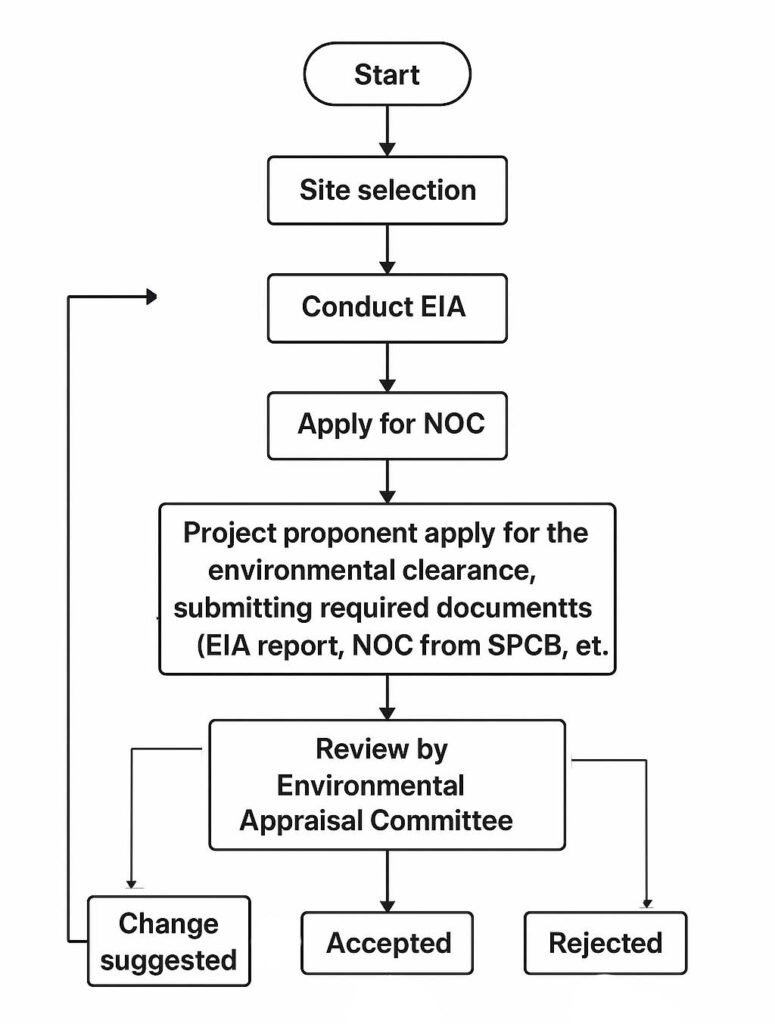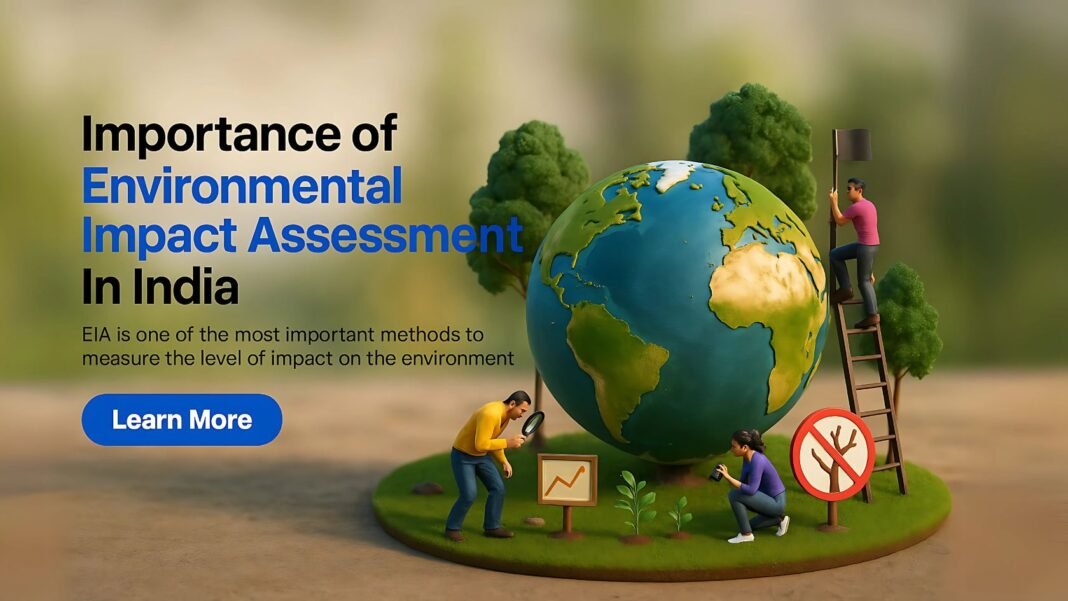A proposed project or activity’s possible environmental effects are assessed using a methodical process called environmental impact assessment, or EIA. EIA is an essential tool for decision-making because it balances environmental and financial factors by comparing different project alternatives to identify the most viable and sustainable option.
- What is EIA?
- Evolution of EIA
- History of EIA in India
- The EIA process
- Forms of impact assessment
- Comparative review of EIA procedures and practices
1. What is an Environmental Impact Assessment (EIA)?
The EIA is a systematic analysis that predicts the environmental impacts—both beneficial and adverse—of a proposed development. It assists in:
- Early identification of environmental implications in project planning,
- Proposing measures to mitigate unwanted impacts,
- Facilitating informed decision-making, and
- Advocating for sustainable development.
When well executed, Environmental Impact Assessment (EIA) can mitigate environmental harm, enhance resource efficiency, conserve time and expenses, and avert disputes by fostering stakeholder involvement and transparency. The advantages of EIA extend across the complete project life cycle, encompassing planning, construction, operation, decommissioning, and post-closure phases.
2. Evolution of EIA
One of the 20th century’s most effective policy innovations for environmental preservation is the EIA. EIA was nonexistent thirty-seven years ago, but it is now a formal procedure in many nations and is used in over 100 countries. When the National Environment Policy Act (NEPA) 1969 went into effect in the US in the early 1970s, the EIA became a required regulatory process. Much of the early development occurred in a few high-income nations, such as Australia, New Zealand, and Canada (1973–74). Some developing nations, like Columbia (1974) and the Philippines (1978), did, however, introduce EIA relatively early.
After the mid-1980s, the EIA process really took off. A borrower nation was required to conduct an EIA under the supervision of the World Bank after the Bank adopted EIA for major development projects in 1989 (see table 1: Evaluation and history of EIA).
Development of EIA |
|
| Pre-1970 | Project review based on the technical/engineering and economic analysis.
Limited consideration given to environmental consequences.
|
| Early/mid – 1970s | NEPA introduced the EIA in the United States in 1970.
The fundamental idea is the establishment of rules, processes, and a requirement for public participation. Impact analysis standard methods (such as matrix, checklist, and network) were developed. In 1973–1974, Canada, Australia, and New Zealand were the first nations to adopt NEPA. In contrast to Australia, which enacted EIA legislation, Canada and New Zealand set up administrative processes. The development of the process is influenced by significant public enquiries. |
| Late 1970 and early 1980s | More official instructions.
Other industrialised and developing nations began implementing the process informally or experimentally (Netherlands, 1978) or adopted elements of it, such as impact statements or reports, as part of development applications for planning permission (German states [lander], Ireland; France, 1976; Philippines, 1977). Other countries also adopted formal EIA requirements. Developing nations’ use of EA (Brazil, Philippines, China, Indonesia) Risk analysis is a component of EA procedures, as is Strategic Environment Assessment (SEA) [1]. increased focus on ecological modelling, forecasting, and assessment techniques. Allowance for public participation. EA and land use planning procedures are coordinated. |
| Mid 1980s to end of decade | All member states in Europe are subject to the fundamental principles and procedural requirements set forth in the EC Directive on EIA.
stepping up initiatives to deal with cumulative effects. EA requirements are set by the World Bank and other prominent international aid organisations. EIA process expansion in Asia. |
| 1990s | The Espoo Convention requires that transboundary effects be taken into account.
increased application of information technologies, including GIS. Global issues and sustainability principles are given more attention. India formally adopted the EIA as well. Many developing nations have formulated EA legislation. EA training is expanding quickly. |
| Source: Barry Sadler’s final report, Environmental Assessment in a Changing World: International Study of the Effectiveness of Environmental Assessment, published in June 1996. | |
| [1]SEA is defined as a policy tool used to evaluate how development plans, policies, and programs affect the environment. [2] Risk assessment is defined as a tool used to estimate the likelihood that a project site will be harmed by the presence of hazardous materials or conditions. Risk is the possibility and importance of a possible hazard materialising. |
|
3. History of EIA in India
Environmental impact assessments were first used in India more than 20 years ago. It began in 1976–1977 when the Planning Commission requested that the Department of Science and Technology conduct an environmental analysis of the river-valley projects. This was later expanded to include those projects that needed Public Investment Board approval. Prior to 1994, the Central Government’s environmental clearance was a decision made administratively without legislative backing.
In accordance with the Environmental (Protection) Act 1986, the Union Ministry of Environment and Forests (MEF), Government of India, issued an EIA notification on January 27, 1994, requiring Environmental Clearance (EC) for any activity that expands or modernizes, as well as for the establishment of new projects listed in Schedule 1 of the notification. Since then, the 1994 EIA notification has undergone twelve revisions.
In September 2006, the MoEF recently announced new EIA legislation. According to the notification, environmental clearance is required for a number of projects, including those involving mining, thermal power plants, river valleys, infrastructure (roads, highways, ports, harbors, and airports), and industries, including very small electroplating or foundry units. However, in contrast to the 1994 EIA Notification, the new law has placed the responsibility for project clearance on the state government, contingent on the project’s size and capacity.
Similar clearance is also needed for some activities that are allowed under the Coastal Regulation Zone Act of 1991. Furthermore, donor organizations with operations in India, such as the World Bank and the Asian Development Bank, have distinct standards for granting environmental approval to projects they fund.
4. The EIA Process: Step-by-Step
The steps in an EIA process are determined by the donor’s or the nation’s requirements. Nonetheless, the majority of EIA procedures share a common framework, and using the primary phases is a fundamental component of best practices.
Each of the eight steps in the environment impact assessment is equally crucial to assessing the project’s overall performance. The EIA process usually starts with screening to make sure time and resources are focused on proposals that have an environmental impact, and it concludes with some kind of follow-up regarding the execution of the choices and actions made in response to an EIA report. Below is a brief overview of the eight steps in the EIA process:
-
Screening: Determines whether a project requires EIA and to what extent.
-
Scoping: Identifies key environmental issues and sets the boundaries of the study.
-
Impact Analysis: Predicts and evaluates likely environmental and social effects.
-
Mitigation: Recommends strategies to prevent or reduce adverse impacts.
-
Reporting: Compiles findings in a formal EIA Report for review and public disclosure.
-
Review: Assesses the adequacy and accuracy of the EIA report.
-
Decision-Making: Approves, rejects, or requests modification of the project based on findings.
-
Post-Monitoring: Ensures compliance with environmental standards and mitigation measures after project implementation.
The overview of the EIA process is represented in figure 1.

5. Forms of Impact Assessment
Several types of impact assessments, including Social Impact Assessment (SIA) and Health Impact Assessment (HIA), are used to evaluate the social and health effects of development so that they are taken into account in addition to the environmental assessment. Strategic environment assessment is one type of impact assessment, and it is covered in brief below:
i. Evaluation of the strategic environment
The term “strategic environment assessment” (SEA) describes the methodical examination of how development plans, policies, programs, and other suggested strategic actions affect the environment. Beyond the project level and when there are still significant options available, this procedure takes the goals and tenets of EIA further upstream in the decision-making process. A proactive strategy for incorporating environmental factors into higher decision-making levels is SEA.
EIA has some limitations as a tool for reducing the environmental effects of development proposals, despite its widespread use and acceptance. It occurs at the downstream end of the decision-making process, comparatively late, after the main options and paths have been selected (see table 3: Difference in EIA and SEA).
Table 3: Difference in EIA and SEA
|
Environment impact assessment |
Strategic environment assessment |
| § Occurs at the conclusion of the cycle of decision-making.
§ Reactive handling of development proposals § Identifies particular environmental impacts § Examines a small number of workable options § Review of cumulative effects is limited. § A focus on reducing and mitigating effects § High level of detail, narrow perspective § A well-defined procedure with a distinct start and finish § Treats signs of environmental degradation and concentrates on the regular agenda. |
§ Takes place at earlier stages of decision making cycle § A proactive approach to suggestions for development § Additionally, it highlights issues of sustainable development and environmental implications. § Examines a wide variety of possible options § A heads-up on cumulative effects § Prioritising environmental goals and preserving natural systems § A broad viewpoint with less detail to give a general framework and vision § Iterative, multi-stage, policy-level, and overlapping components § Addresses the causes of environmental degradation and concentrates on the sustainability agenda
|
| Source: United Nations Development Program’s EIA Training Resource Manual, Second Edition, 2002 | |
Up until 1990, SEA was not widely developed or used. However, several developed economies adopted SEA after 1990. In certain nations, like Canada and Denmark, provisions for SEA of policies, plans, and programs have been established independently of EIA laws and procedures. Other nations, like the Czech Republic, Slovakia, and others, have implemented SEA requirements by amending their EIA laws, and the UK has done so through environmental appraisal. In contrast, it is a component of resource management or biodiversity conservation regimes in Australia and New Zealand. With the European Union’s directives and the signatory countries’ Protocol to the UNECE Convention on Transboundary EIA (which has a provisional completion date of May 2003), the adoption of SEA is expected to increase significantly in the upcoming years.
6. Comparative review of EIA procedures and practices
| Developed countries | EIA in developing countries | EIA in India |
| EIA laws are well-drafted. For example, the Canadian Environmental Assessment Act governs EIA in Canada, whereas the Directive on EIA (1985) governs EU nations. | Many developing nations lack formal EIA legislation. For example, many African nations do not require EIAs. | EIA formal laws It was passed by modification to the Environmental Protection Act 1986. |
| Early on in the EIA process, all parties involved—including the affected individuals, government agencies, and the competent authority—should actively participate in developed nations. This strengthens the procedure and provides a reasonable understanding of the problems that must be resolved in the first stage of the EIA. | Public and government agencies were not heavily involved in the early stages. This frequently leads to a subpar portrayal of the problems and effects in the report, which detracts from its overall quality. | Public and government agencies’ limited participation in the first phases. |
| An integrated approach to EIA was used. Every element is considered, including social and health factors. | Primarily taking into account environmental factors. inadequate in terms of health or social aspects. | Not one clause in the Indian EIA rules to address visual impacts and landscape changes. |
| Taking alternatives into account in an EIA | Alternatives are largely ignored in developing nations. | Similar to developing nations |
| The screening procedure is clearly laid out. For example, in EU nations, competent authorities consult with developers, non-governmental organisations, and statutory consultees before determining whether an EIA is necessary. In Japan, the authorising agency makes the screening decision based on specific criteria. In Canada, whether or not an environmental assessment is necessary is decided by federal authority. | EIA screening procedures are inadequate in developing nations. The majority of the time, there is a list of activities that need an EIA but no threshold values. | Screening is conducted following a predetermined list. Threshold values regarding the project’s scale have been implemented to determine whether the state or central governments will approve the project. |
| All stakeholders are consulted during the thorough scoping process. In many nations, including the US, the Netherlands, Canada, and Europe, the scoping process takes into account the public’s involvement and concerns. In addition, funding agencies like the World Bank, ADB, and ERDB allow for consultation with NGOs and those impacted when identifying issues during the scoping process. | In the majority of developing nations, the scoping process is not well defined. Scoping is not allowed in many nations, such as China, Pakistan, etc. While some nations, like Ghana, Taiwan, and Chile, use a general checklist for scoping, others, like Nigeria and Indonesia, use a term of reference. There is no public consultation during scoping in the countries where it is conducted. Furthermore, rather than considering the entire spectrum of possible environmental effects from a proposed development, scoping is frequently focused on fulfilling pollution control regulations in the majority of developing nations. | Previously, scoping was conducted by a consultant or proponent with a focus on meeting pollution control requirements, rather than considering the complete spectrum of potential environmental impacts from a proposed development. Nevertheless, the expert committee has been assigned the responsibility of scoping in accordance with the information provided by the proponent, as per the new notification. The expert committee has the discretion to determine whether or not to engage in public consultation.
|
| The majority of reports are in the local tongue. | The majority of reports are in English rather than the native tongue. | The majority of reports are written in English, rather than the local language. In certain instances, the executive summary is translated into the local language. |
| A multidisciplinary strategy. participation of specialists with a variety of specialities. | In developing nations, a shortage of qualified EIA specialists frequently results in the creation of subpar and unnecessary EIA reports. | The same is true in India. Consultants conduct the EIA preparation. Consequently, the organization’s selection criterion is fees/cost, rather than the expertise of the EIA team. |
| There are two levels of EIA review: one is carried out to assess the effectiveness and sufficiency of the EIA after it is finished, and the other is carried out prior to decision-making. | Inadequate monitoring or review. | The EIA evaluation in India is also subpar. The Impact Assessment Agency (IAA) is a review agency that lacks inter-disciplinary capacity. The EIA notification is violated by the absence of NGO representation in the IAA. |
| EIA expertise: The International Association for Impact Assessment (AIA) and other organisations show that many people from Northern countries are capable of designing, carrying out, reviewing, and evaluating EIAs. The majority of environmental assessment instruction also occurs in industrialised nations. | One is gradually getting the knowledge in EIA. Usually, students from underdeveloped nations travel to developed ones in order to learn the topic. | Expertise in this field is expanding. |
| Source: Compiled by Industry & Environment Unit, Centre for Science & Environment, 2006 | ||



